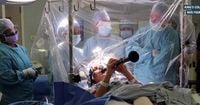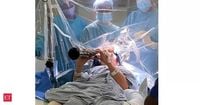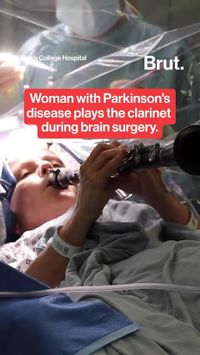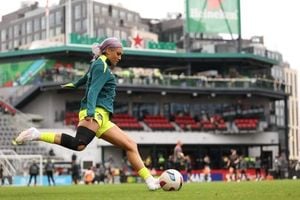In a remarkable blend of medical innovation and musical passion, Denise Bacon, a 65-year-old retired speech and language therapist from Crowborough, East Sussex, played her beloved clarinet while undergoing brain surgery at King’s College Hospital in London. Her performance wasn’t just for show—it was a crucial part of a groundbreaking Deep Brain Stimulation (DBS) procedure aimed at alleviating the debilitating symptoms of Parkinson’s disease that had steadily eroded her ability to move, walk, swim, dance, and play music.
Bacon’s journey with Parkinson’s began in 2014. Once an active member of the East Grinstead Concert Band, she was forced to give up her seat five years ago as bradykinesia (slowness of movement) and rigidity made music—and much else—increasingly difficult. "I remember my right hand being able to move with much more ease once the stimulation was applied, and this in turn improved my ability to play the clarinet, which I was delighted with," Bacon recalled, her voice conveying both relief and hope, according to King’s College Hospital’s press release.
The innovative procedure, performed in July 2025, was led by Professor Keyoumars Ashkan MBE, Professor of Neurosurgery, and supported by a multidisciplinary team including a neurologist, neuropsychologist, and specialized nursing staff. The operation lasted four hours, during which Bacon remained awake under local anesthesia—her scalp and skull numbed, but her mind and senses fully alert. This allowed the surgical team to monitor her symptoms in real time and precisely adjust the stimulation as needed.
DBS is a well-established surgical intervention for patients with treatment-resistant movement disorders such as Parkinson’s. The process involves implanting electrodes into targeted deep brain structures. To achieve this, surgeons first secured a frame with precise coordinates onto Bacon’s head, acting as a sort of neurological GPS. With this guidance, they drilled small holes—each about half the size of a five pence piece—into her skull. The electrodes were then carefully threaded into place, one hemisphere at a time.
"Deep Brain Stimulation, where stimulating electrodes are placed into the deep structures of the brain, is a long-established procedure to improve motor symptoms in patients with movement disorders," Professor Ashkan explained, according to The Economic Times. "As a keen clarinettist, it was suggested Denise bring her clarinet into the operating theatre to see whether the procedure would improve her ability to play, which was one of Denise’s main goals for the surgery. We were delighted to see an instant improvement in her hand movements, and therefore her ability to play, once stimulation was delivered to the brain."
Bacon’s clarinet playing served as both a test and a celebration. As the electrodes were activated, the transformation was immediate—her shaking subsided, her fingers steadied, and the music flowed. "The results were instantaneous on the operating table," read the hospital’s release. "The movement in Denise’s fingers improved immediately, allowing her to play the clarinet with much greater ease." It was, as one observer put it, "part miracle, part jam session, and proof that sometimes the best way to fine-tune the brain is to give it a solo."
The electrodes were connected to a rechargeable pulse generator implanted in Bacon’s chest, similar in concept to a cardiac pacemaker. This device delivers continuous electrical impulses to the brain, modifying neural activity and reducing the severity of Parkinson’s symptoms. Notably, the latest models of these generators are equipped with smart technology: they monitor ongoing brain activity and can automatically adjust the level of stimulation as needed, personalizing treatment in real time. The battery is designed to last up to 20 years before needing replacement, offering Bacon a long-term solution with minimal maintenance.
For Bacon, the improvements have extended beyond her music. She’s already noticed enhanced ease in walking—a significant milestone given the progressive nature of Parkinson’s. "I’m already experiencing improvements in my ability to walk, and I’m keen to get back in the swimming pool, and on the dance floor to see if my abilities have improved there," she said, her optimism palpable. Her story highlights not only the technical achievements of the surgical team but also the profound impact such interventions can have on restoring a patient’s quality of life.
The procedure itself is not without its challenges. The brain, curiously, lacks pain receptors, allowing patients like Bacon to remain awake and responsive during surgery. This awake state is vital: it enables surgeons to receive immediate feedback, adjusting electrode placement and stimulation levels to maximize benefit and minimize unwanted side effects. In Bacon’s case, the strategy paid off handsomely, with both the operating team and patient witnessing tangible results in real time.
Parkinson’s disease, which affects millions worldwide, is characterized by the gradual loss of dopamine-producing neurons in the brain. This leads to symptoms such as tremors, stiffness, slowness of movement, and impaired balance. While medications can help manage early symptoms, many patients eventually face diminishing returns, prompting the search for surgical solutions like DBS. The technology has evolved rapidly, with advances in imaging, electrode design, and battery life making the procedure safer and more effective than ever before.
Bacon’s case has drawn attention not just for its technical novelty but for its human dimension. The sight—and sound—of a patient reclaiming a cherished activity in the midst of brain surgery is both poignant and inspiring. It underscores the importance of personalizing medical care, aligning treatment goals with what matters most to patients. For Bacon, the ability to play the clarinet again was more than a medical milestone; it was a return to self, a rekindling of joy and identity lost to illness.
Professor Ashkan and his team see Bacon’s successful surgery as emblematic of what’s possible when technology, expertise, and patient-centered care converge. As he put it, "We were delighted to see an instant improvement in her hand movements, and therefore her ability to play, once stimulation was delivered to the brain." The hope is that more patients like Bacon will benefit from DBS and similar interventions, regaining not only physical abilities but also the passions that give life meaning.
With her new pulse generator quietly humming beneath her skin, Bacon looks forward to a future filled with music, movement, and renewed possibility. Her story is a testament to the resilience of the human spirit—and to the power of modern medicine to restore it, one note at a time.






